CNA632 Essay: 21st Century Learning in Healthcare Training Programs
VerifiedAdded on 2022/08/28
|12
|3114
|9
Essay
AI Summary
This essay delves into the complexities of training and learning within the healthcare sector, emphasizing the need for effective strategies to develop 21st-century learners. It analyzes the key characteristics of contemporary learners, the importance of well-designed training programs, and the significance of feedback mechanisms in nursing education. The essay highlights the evolution of teaching practices to meet the demands of a changing industry, focusing on creative, innovative, and self-directed learning approaches. It explores the use of technologies, problem-based learning, and simulation to enhance training effectiveness. Furthermore, it examines the role of feedback in program improvement and the integration of experiential learning theories. The essay references various research studies to support its arguments and concludes by emphasizing the importance of adapting training programs to meet the evolving needs of healthcare professionals, ensuring they possess the critical thinking and communication skills required in the modern healthcare landscape.
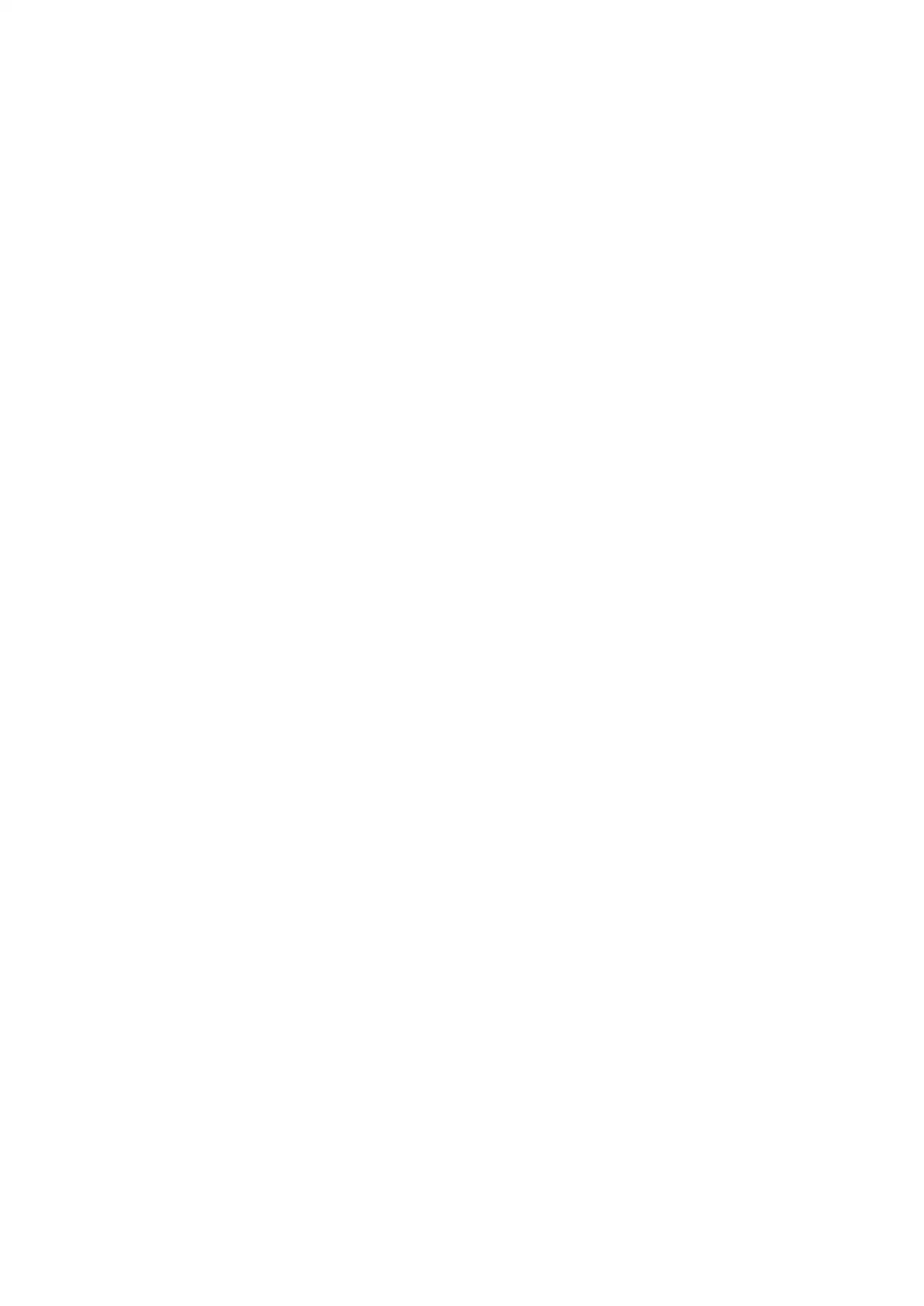
Paraphrase This Document
Need a fresh take? Get an instant paraphrase of this document with our AI Paraphraser
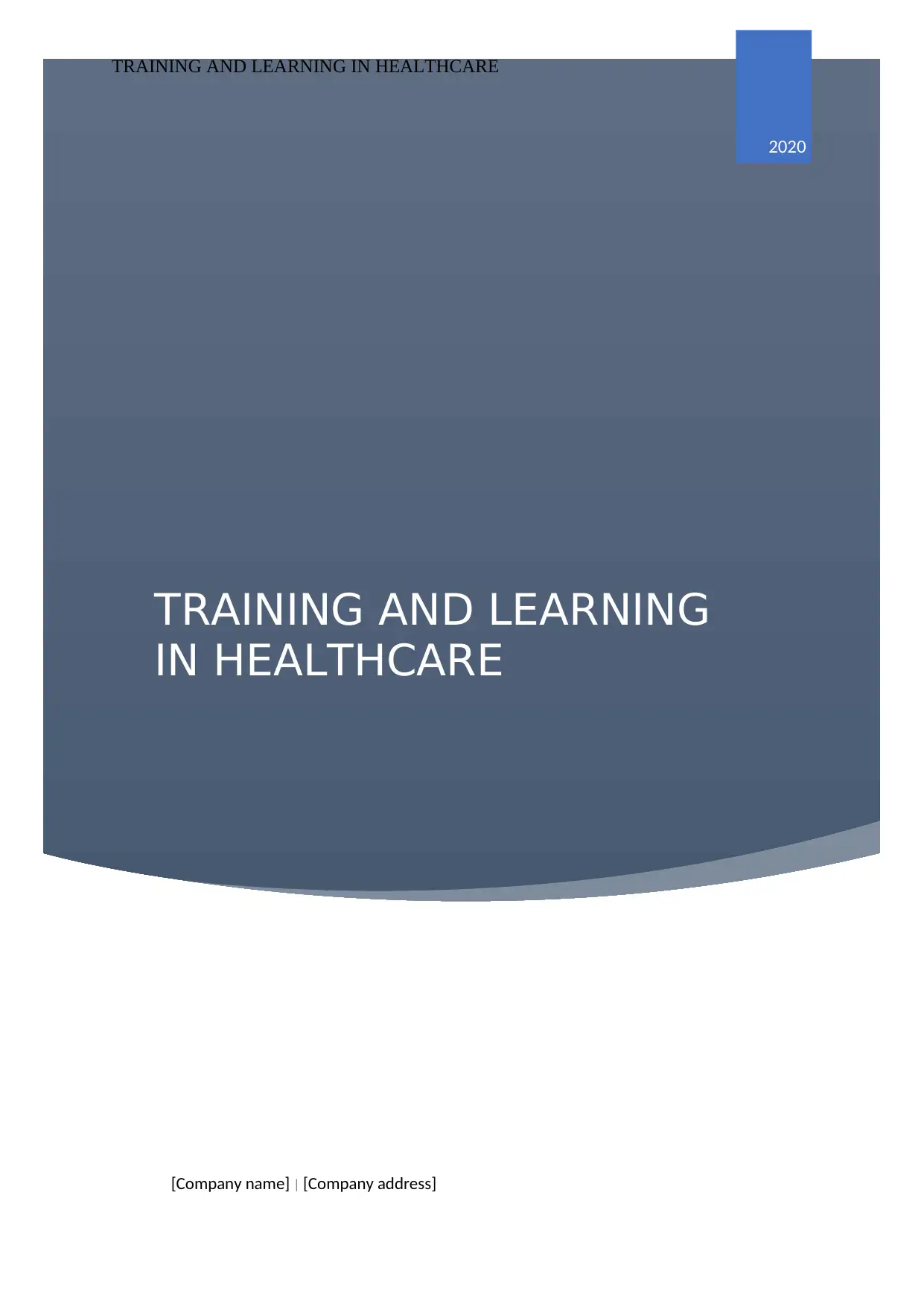
TRAINING AND LEARNING
IN HEALTHCARE
TRAINING AND LEARNING IN HEALTHCARE 1 | P a g e
2020
[Company name] | [Company address]
IN HEALTHCARE
TRAINING AND LEARNING IN HEALTHCARE 1 | P a g e
2020
[Company name] | [Company address]
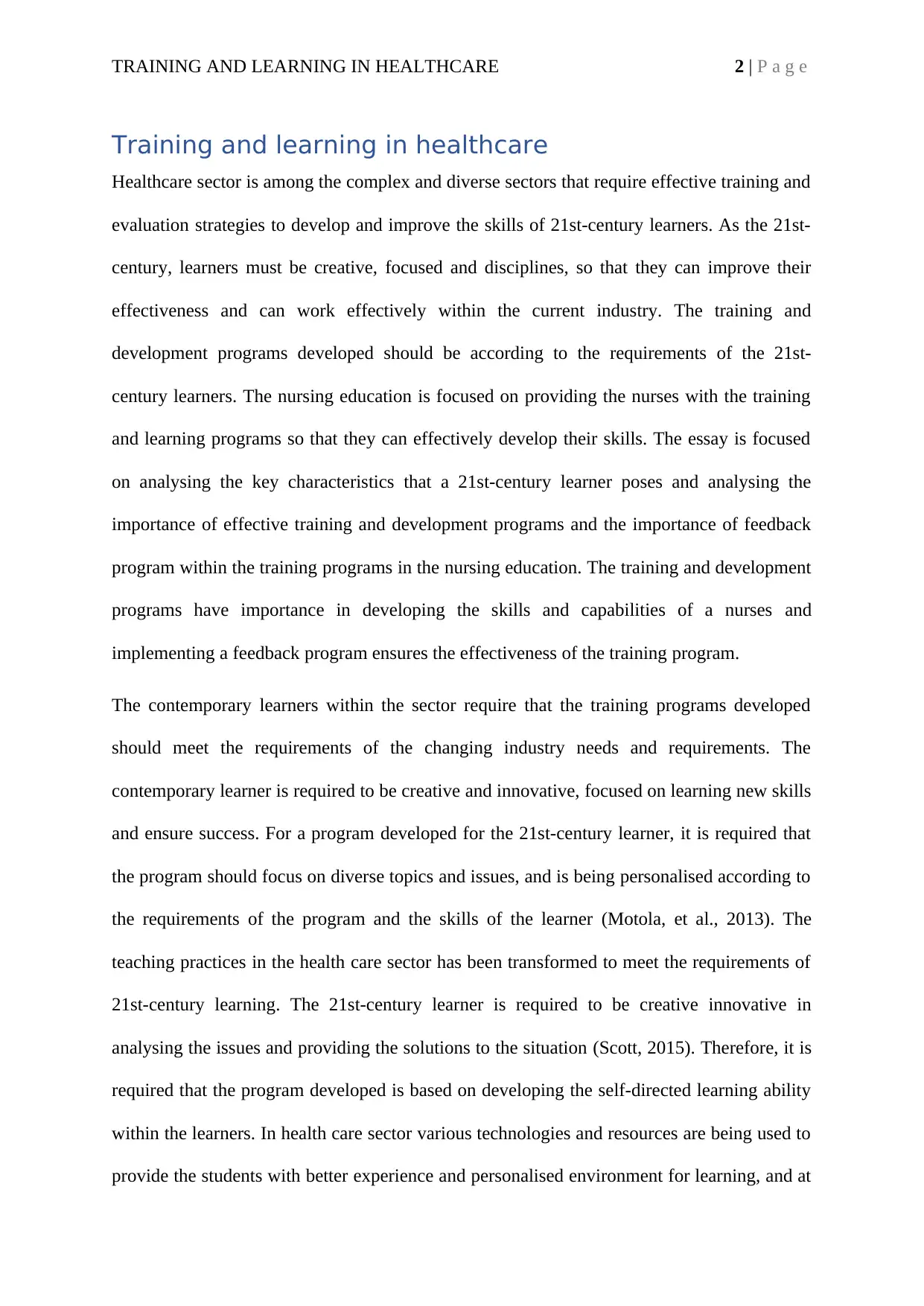
TRAINING AND LEARNING IN HEALTHCARE 2 | P a g e
Training and learning in healthcare
Healthcare sector is among the complex and diverse sectors that require effective training and
evaluation strategies to develop and improve the skills of 21st-century learners. As the 21st-
century, learners must be creative, focused and disciplines, so that they can improve their
effectiveness and can work effectively within the current industry. The training and
development programs developed should be according to the requirements of the 21st-
century learners. The nursing education is focused on providing the nurses with the training
and learning programs so that they can effectively develop their skills. The essay is focused
on analysing the key characteristics that a 21st-century learner poses and analysing the
importance of effective training and development programs and the importance of feedback
program within the training programs in the nursing education. The training and development
programs have importance in developing the skills and capabilities of a nurses and
implementing a feedback program ensures the effectiveness of the training program.
The contemporary learners within the sector require that the training programs developed
should meet the requirements of the changing industry needs and requirements. The
contemporary learner is required to be creative and innovative, focused on learning new skills
and ensure success. For a program developed for the 21st-century learner, it is required that
the program should focus on diverse topics and issues, and is being personalised according to
the requirements of the program and the skills of the learner (Motola, et al., 2013). The
teaching practices in the health care sector has been transformed to meet the requirements of
21st-century learning. The 21st-century learner is required to be creative innovative in
analysing the issues and providing the solutions to the situation (Scott, 2015). Therefore, it is
required that the program developed is based on developing the self-directed learning ability
within the learners. In health care sector various technologies and resources are being used to
provide the students with better experience and personalised environment for learning, and at
Training and learning in healthcare
Healthcare sector is among the complex and diverse sectors that require effective training and
evaluation strategies to develop and improve the skills of 21st-century learners. As the 21st-
century, learners must be creative, focused and disciplines, so that they can improve their
effectiveness and can work effectively within the current industry. The training and
development programs developed should be according to the requirements of the 21st-
century learners. The nursing education is focused on providing the nurses with the training
and learning programs so that they can effectively develop their skills. The essay is focused
on analysing the key characteristics that a 21st-century learner poses and analysing the
importance of effective training and development programs and the importance of feedback
program within the training programs in the nursing education. The training and development
programs have importance in developing the skills and capabilities of a nurses and
implementing a feedback program ensures the effectiveness of the training program.
The contemporary learners within the sector require that the training programs developed
should meet the requirements of the changing industry needs and requirements. The
contemporary learner is required to be creative and innovative, focused on learning new skills
and ensure success. For a program developed for the 21st-century learner, it is required that
the program should focus on diverse topics and issues, and is being personalised according to
the requirements of the program and the skills of the learner (Motola, et al., 2013). The
teaching practices in the health care sector has been transformed to meet the requirements of
21st-century learning. The 21st-century learner is required to be creative innovative in
analysing the issues and providing the solutions to the situation (Scott, 2015). Therefore, it is
required that the program developed is based on developing the self-directed learning ability
within the learners. In health care sector various technologies and resources are being used to
provide the students with better experience and personalised environment for learning, and at
⊘ This is a preview!⊘
Do you want full access?
Subscribe today to unlock all pages.

Trusted by 1+ million students worldwide
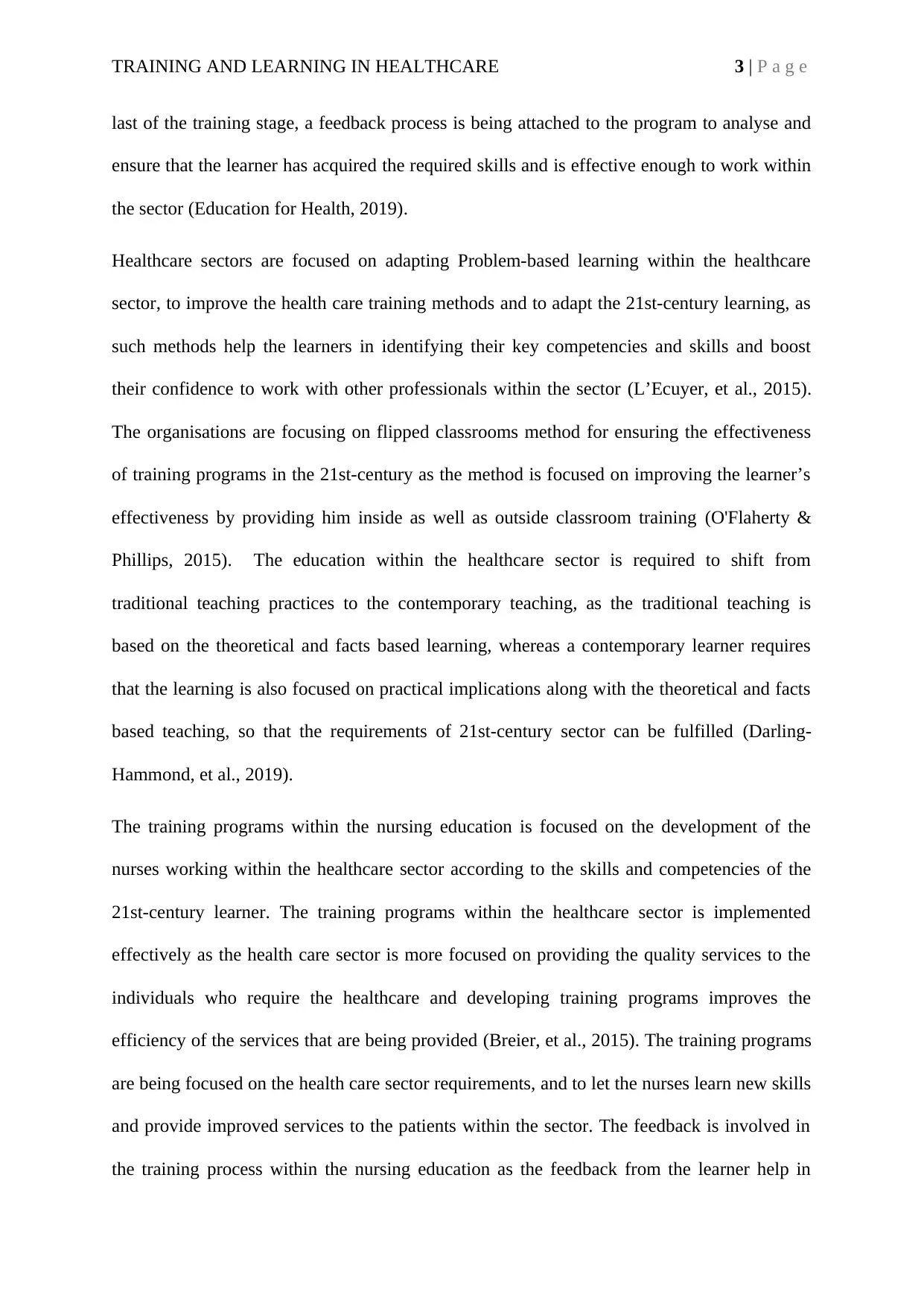
TRAINING AND LEARNING IN HEALTHCARE 3 | P a g e
last of the training stage, a feedback process is being attached to the program to analyse and
ensure that the learner has acquired the required skills and is effective enough to work within
the sector (Education for Health, 2019).
Healthcare sectors are focused on adapting Problem-based learning within the healthcare
sector, to improve the health care training methods and to adapt the 21st-century learning, as
such methods help the learners in identifying their key competencies and skills and boost
their confidence to work with other professionals within the sector (L’Ecuyer, et al., 2015).
The organisations are focusing on flipped classrooms method for ensuring the effectiveness
of training programs in the 21st-century as the method is focused on improving the learner’s
effectiveness by providing him inside as well as outside classroom training (O'Flaherty &
Phillips, 2015). The education within the healthcare sector is required to shift from
traditional teaching practices to the contemporary teaching, as the traditional teaching is
based on the theoretical and facts based learning, whereas a contemporary learner requires
that the learning is also focused on practical implications along with the theoretical and facts
based teaching, so that the requirements of 21st-century sector can be fulfilled (Darling-
Hammond, et al., 2019).
The training programs within the nursing education is focused on the development of the
nurses working within the healthcare sector according to the skills and competencies of the
21st-century learner. The training programs within the healthcare sector is implemented
effectively as the health care sector is more focused on providing the quality services to the
individuals who require the healthcare and developing training programs improves the
efficiency of the services that are being provided (Breier, et al., 2015). The training programs
are being focused on the health care sector requirements, and to let the nurses learn new skills
and provide improved services to the patients within the sector. The feedback is involved in
the training process within the nursing education as the feedback from the learner help in
last of the training stage, a feedback process is being attached to the program to analyse and
ensure that the learner has acquired the required skills and is effective enough to work within
the sector (Education for Health, 2019).
Healthcare sectors are focused on adapting Problem-based learning within the healthcare
sector, to improve the health care training methods and to adapt the 21st-century learning, as
such methods help the learners in identifying their key competencies and skills and boost
their confidence to work with other professionals within the sector (L’Ecuyer, et al., 2015).
The organisations are focusing on flipped classrooms method for ensuring the effectiveness
of training programs in the 21st-century as the method is focused on improving the learner’s
effectiveness by providing him inside as well as outside classroom training (O'Flaherty &
Phillips, 2015). The education within the healthcare sector is required to shift from
traditional teaching practices to the contemporary teaching, as the traditional teaching is
based on the theoretical and facts based learning, whereas a contemporary learner requires
that the learning is also focused on practical implications along with the theoretical and facts
based teaching, so that the requirements of 21st-century sector can be fulfilled (Darling-
Hammond, et al., 2019).
The training programs within the nursing education is focused on the development of the
nurses working within the healthcare sector according to the skills and competencies of the
21st-century learner. The training programs within the healthcare sector is implemented
effectively as the health care sector is more focused on providing the quality services to the
individuals who require the healthcare and developing training programs improves the
efficiency of the services that are being provided (Breier, et al., 2015). The training programs
are being focused on the health care sector requirements, and to let the nurses learn new skills
and provide improved services to the patients within the sector. The feedback is involved in
the training process within the nursing education as the feedback from the learner help in
Paraphrase This Document
Need a fresh take? Get an instant paraphrase of this document with our AI Paraphraser
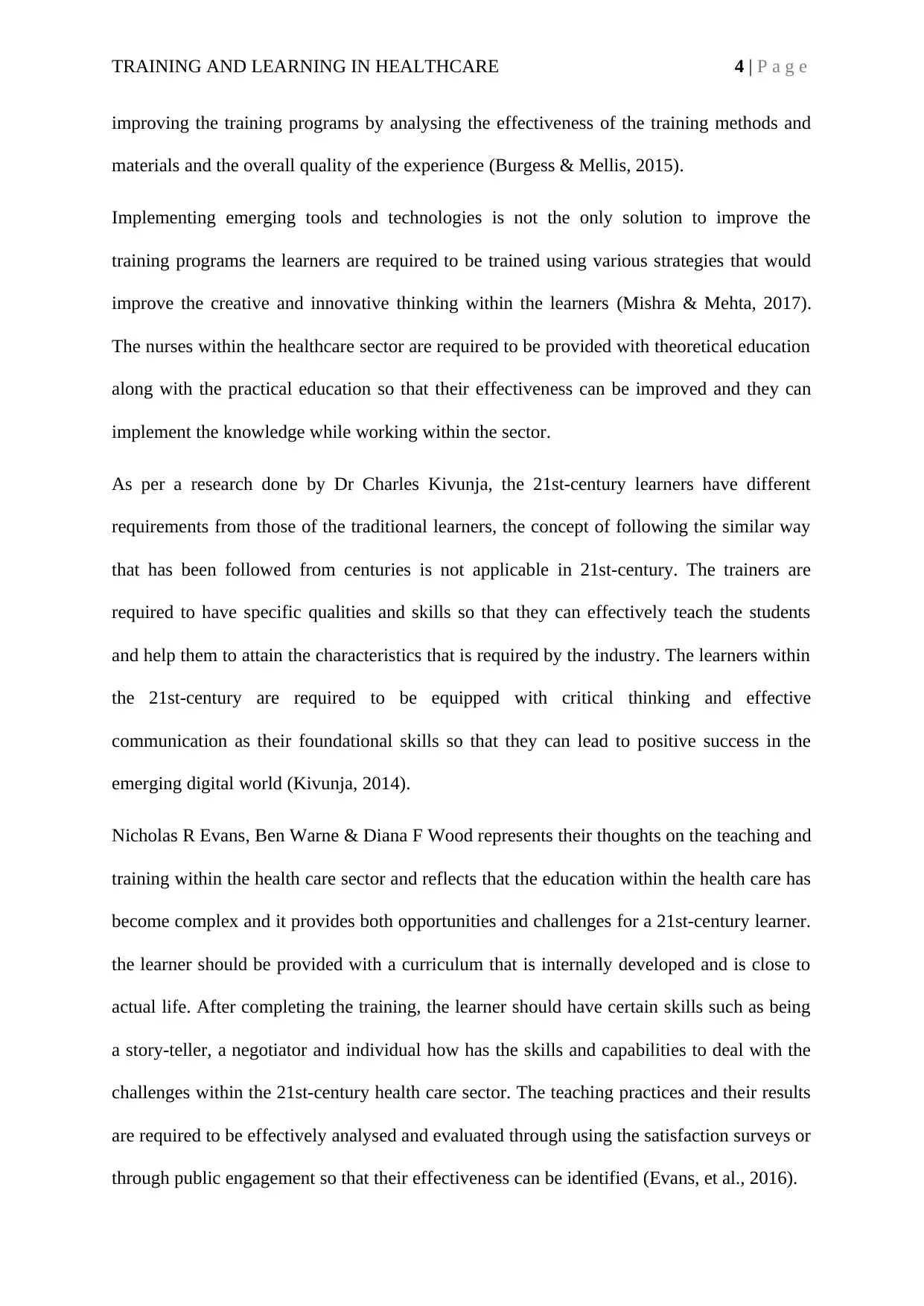
TRAINING AND LEARNING IN HEALTHCARE 4 | P a g e
improving the training programs by analysing the effectiveness of the training methods and
materials and the overall quality of the experience (Burgess & Mellis, 2015).
Implementing emerging tools and technologies is not the only solution to improve the
training programs the learners are required to be trained using various strategies that would
improve the creative and innovative thinking within the learners (Mishra & Mehta, 2017).
The nurses within the healthcare sector are required to be provided with theoretical education
along with the practical education so that their effectiveness can be improved and they can
implement the knowledge while working within the sector.
As per a research done by Dr Charles Kivunja, the 21st-century learners have different
requirements from those of the traditional learners, the concept of following the similar way
that has been followed from centuries is not applicable in 21st-century. The trainers are
required to have specific qualities and skills so that they can effectively teach the students
and help them to attain the characteristics that is required by the industry. The learners within
the 21st-century are required to be equipped with critical thinking and effective
communication as their foundational skills so that they can lead to positive success in the
emerging digital world (Kivunja, 2014).
Nicholas R Evans, Ben Warne & Diana F Wood represents their thoughts on the teaching and
training within the health care sector and reflects that the education within the health care has
become complex and it provides both opportunities and challenges for a 21st-century learner.
the learner should be provided with a curriculum that is internally developed and is close to
actual life. After completing the training, the learner should have certain skills such as being
a story-teller, a negotiator and individual how has the skills and capabilities to deal with the
challenges within the 21st-century health care sector. The teaching practices and their results
are required to be effectively analysed and evaluated through using the satisfaction surveys or
through public engagement so that their effectiveness can be identified (Evans, et al., 2016).
improving the training programs by analysing the effectiveness of the training methods and
materials and the overall quality of the experience (Burgess & Mellis, 2015).
Implementing emerging tools and technologies is not the only solution to improve the
training programs the learners are required to be trained using various strategies that would
improve the creative and innovative thinking within the learners (Mishra & Mehta, 2017).
The nurses within the healthcare sector are required to be provided with theoretical education
along with the practical education so that their effectiveness can be improved and they can
implement the knowledge while working within the sector.
As per a research done by Dr Charles Kivunja, the 21st-century learners have different
requirements from those of the traditional learners, the concept of following the similar way
that has been followed from centuries is not applicable in 21st-century. The trainers are
required to have specific qualities and skills so that they can effectively teach the students
and help them to attain the characteristics that is required by the industry. The learners within
the 21st-century are required to be equipped with critical thinking and effective
communication as their foundational skills so that they can lead to positive success in the
emerging digital world (Kivunja, 2014).
Nicholas R Evans, Ben Warne & Diana F Wood represents their thoughts on the teaching and
training within the health care sector and reflects that the education within the health care has
become complex and it provides both opportunities and challenges for a 21st-century learner.
the learner should be provided with a curriculum that is internally developed and is close to
actual life. After completing the training, the learner should have certain skills such as being
a story-teller, a negotiator and individual how has the skills and capabilities to deal with the
challenges within the 21st-century health care sector. The teaching practices and their results
are required to be effectively analysed and evaluated through using the satisfaction surveys or
through public engagement so that their effectiveness can be identified (Evans, et al., 2016).
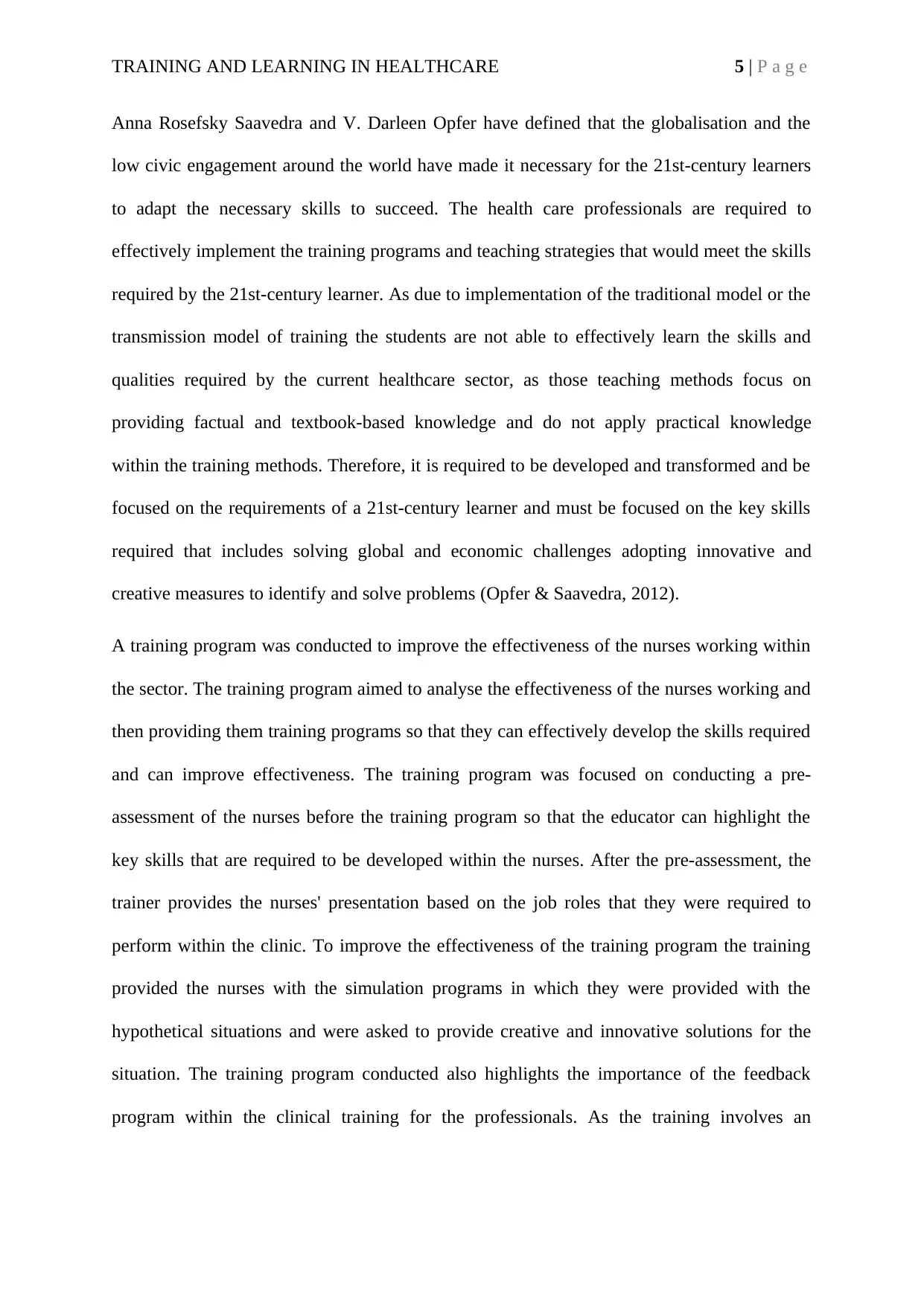
TRAINING AND LEARNING IN HEALTHCARE 5 | P a g e
Anna Rosefsky Saavedra and V. Darleen Opfer have defined that the globalisation and the
low civic engagement around the world have made it necessary for the 21st-century learners
to adapt the necessary skills to succeed. The health care professionals are required to
effectively implement the training programs and teaching strategies that would meet the skills
required by the 21st-century learner. As due to implementation of the traditional model or the
transmission model of training the students are not able to effectively learn the skills and
qualities required by the current healthcare sector, as those teaching methods focus on
providing factual and textbook-based knowledge and do not apply practical knowledge
within the training methods. Therefore, it is required to be developed and transformed and be
focused on the requirements of a 21st-century learner and must be focused on the key skills
required that includes solving global and economic challenges adopting innovative and
creative measures to identify and solve problems (Opfer & Saavedra, 2012).
A training program was conducted to improve the effectiveness of the nurses working within
the sector. The training program aimed to analyse the effectiveness of the nurses working and
then providing them training programs so that they can effectively develop the skills required
and can improve effectiveness. The training program was focused on conducting a pre-
assessment of the nurses before the training program so that the educator can highlight the
key skills that are required to be developed within the nurses. After the pre-assessment, the
trainer provides the nurses' presentation based on the job roles that they were required to
perform within the clinic. To improve the effectiveness of the training program the training
provided the nurses with the simulation programs in which they were provided with the
hypothetical situations and were asked to provide creative and innovative solutions for the
situation. The training program conducted also highlights the importance of the feedback
program within the clinical training for the professionals. As the training involves an
Anna Rosefsky Saavedra and V. Darleen Opfer have defined that the globalisation and the
low civic engagement around the world have made it necessary for the 21st-century learners
to adapt the necessary skills to succeed. The health care professionals are required to
effectively implement the training programs and teaching strategies that would meet the skills
required by the 21st-century learner. As due to implementation of the traditional model or the
transmission model of training the students are not able to effectively learn the skills and
qualities required by the current healthcare sector, as those teaching methods focus on
providing factual and textbook-based knowledge and do not apply practical knowledge
within the training methods. Therefore, it is required to be developed and transformed and be
focused on the requirements of a 21st-century learner and must be focused on the key skills
required that includes solving global and economic challenges adopting innovative and
creative measures to identify and solve problems (Opfer & Saavedra, 2012).
A training program was conducted to improve the effectiveness of the nurses working within
the sector. The training program aimed to analyse the effectiveness of the nurses working and
then providing them training programs so that they can effectively develop the skills required
and can improve effectiveness. The training program was focused on conducting a pre-
assessment of the nurses before the training program so that the educator can highlight the
key skills that are required to be developed within the nurses. After the pre-assessment, the
trainer provides the nurses' presentation based on the job roles that they were required to
perform within the clinic. To improve the effectiveness of the training program the training
provided the nurses with the simulation programs in which they were provided with the
hypothetical situations and were asked to provide creative and innovative solutions for the
situation. The training program conducted also highlights the importance of the feedback
program within the clinical training for the professionals. As the training involves an
⊘ This is a preview!⊘
Do you want full access?
Subscribe today to unlock all pages.

Trusted by 1+ million students worldwide
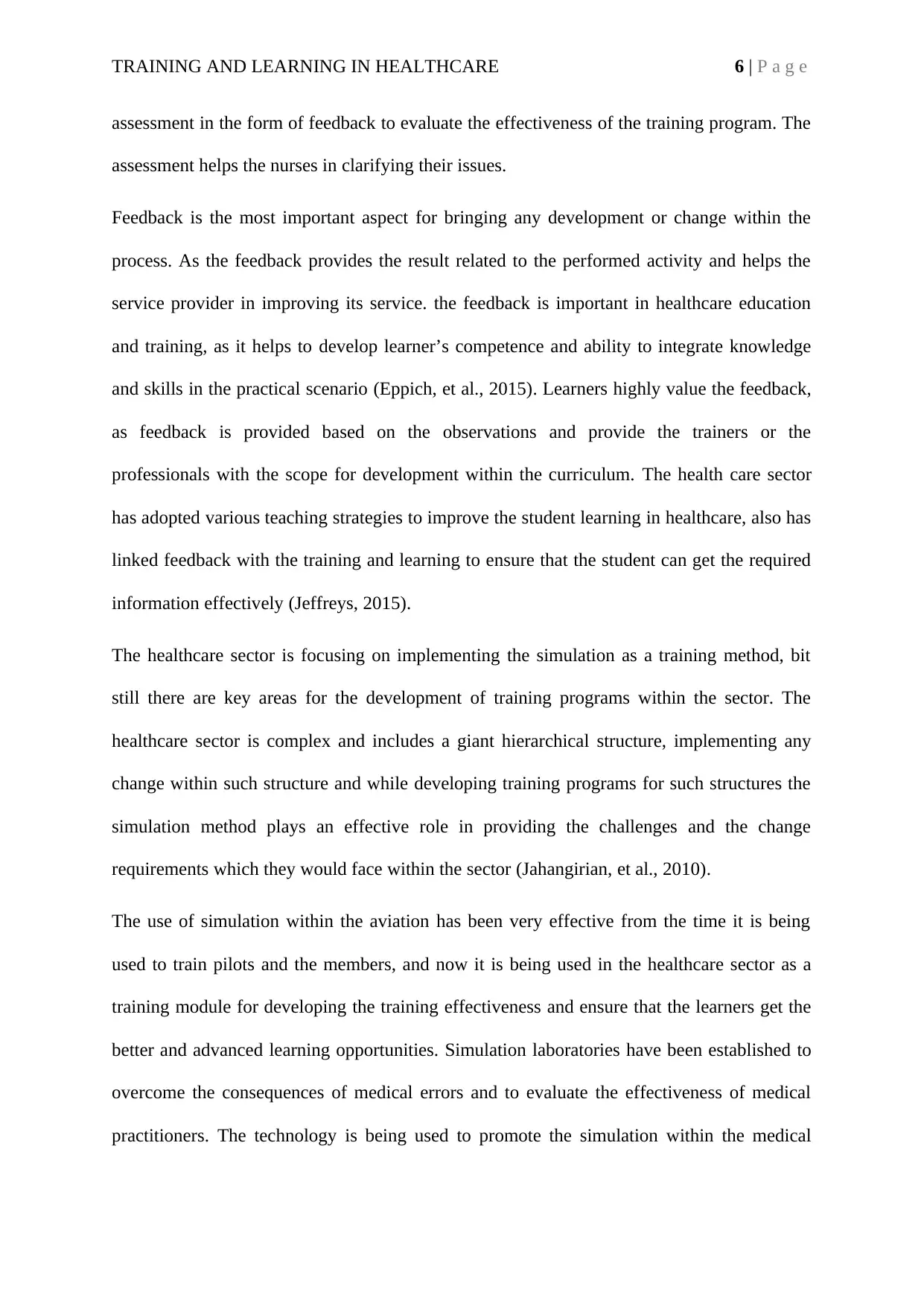
TRAINING AND LEARNING IN HEALTHCARE 6 | P a g e
assessment in the form of feedback to evaluate the effectiveness of the training program. The
assessment helps the nurses in clarifying their issues.
Feedback is the most important aspect for bringing any development or change within the
process. As the feedback provides the result related to the performed activity and helps the
service provider in improving its service. the feedback is important in healthcare education
and training, as it helps to develop learner’s competence and ability to integrate knowledge
and skills in the practical scenario (Eppich, et al., 2015). Learners highly value the feedback,
as feedback is provided based on the observations and provide the trainers or the
professionals with the scope for development within the curriculum. The health care sector
has adopted various teaching strategies to improve the student learning in healthcare, also has
linked feedback with the training and learning to ensure that the student can get the required
information effectively (Jeffreys, 2015).
The healthcare sector is focusing on implementing the simulation as a training method, bit
still there are key areas for the development of training programs within the sector. The
healthcare sector is complex and includes a giant hierarchical structure, implementing any
change within such structure and while developing training programs for such structures the
simulation method plays an effective role in providing the challenges and the change
requirements which they would face within the sector (Jahangirian, et al., 2010).
The use of simulation within the aviation has been very effective from the time it is being
used to train pilots and the members, and now it is being used in the healthcare sector as a
training module for developing the training effectiveness and ensure that the learners get the
better and advanced learning opportunities. Simulation laboratories have been established to
overcome the consequences of medical errors and to evaluate the effectiveness of medical
practitioners. The technology is being used to promote the simulation within the medical
assessment in the form of feedback to evaluate the effectiveness of the training program. The
assessment helps the nurses in clarifying their issues.
Feedback is the most important aspect for bringing any development or change within the
process. As the feedback provides the result related to the performed activity and helps the
service provider in improving its service. the feedback is important in healthcare education
and training, as it helps to develop learner’s competence and ability to integrate knowledge
and skills in the practical scenario (Eppich, et al., 2015). Learners highly value the feedback,
as feedback is provided based on the observations and provide the trainers or the
professionals with the scope for development within the curriculum. The health care sector
has adopted various teaching strategies to improve the student learning in healthcare, also has
linked feedback with the training and learning to ensure that the student can get the required
information effectively (Jeffreys, 2015).
The healthcare sector is focusing on implementing the simulation as a training method, bit
still there are key areas for the development of training programs within the sector. The
healthcare sector is complex and includes a giant hierarchical structure, implementing any
change within such structure and while developing training programs for such structures the
simulation method plays an effective role in providing the challenges and the change
requirements which they would face within the sector (Jahangirian, et al., 2010).
The use of simulation within the aviation has been very effective from the time it is being
used to train pilots and the members, and now it is being used in the healthcare sector as a
training module for developing the training effectiveness and ensure that the learners get the
better and advanced learning opportunities. Simulation laboratories have been established to
overcome the consequences of medical errors and to evaluate the effectiveness of medical
practitioners. The technology is being used to promote the simulation within the medical
Paraphrase This Document
Need a fresh take? Get an instant paraphrase of this document with our AI Paraphraser
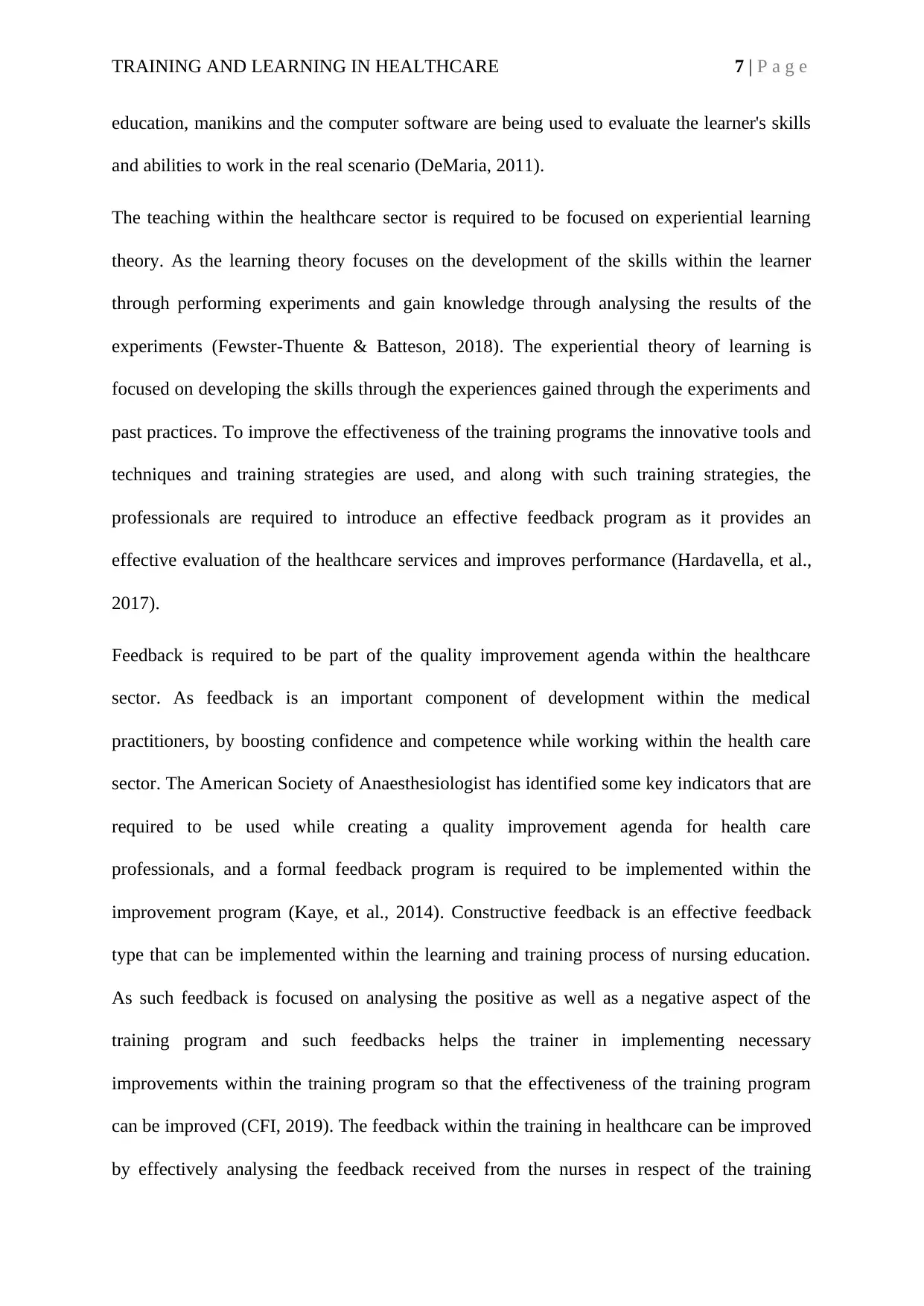
TRAINING AND LEARNING IN HEALTHCARE 7 | P a g e
education, manikins and the computer software are being used to evaluate the learner's skills
and abilities to work in the real scenario (DeMaria, 2011).
The teaching within the healthcare sector is required to be focused on experiential learning
theory. As the learning theory focuses on the development of the skills within the learner
through performing experiments and gain knowledge through analysing the results of the
experiments (Fewster-Thuente & Batteson, 2018). The experiential theory of learning is
focused on developing the skills through the experiences gained through the experiments and
past practices. To improve the effectiveness of the training programs the innovative tools and
techniques and training strategies are used, and along with such training strategies, the
professionals are required to introduce an effective feedback program as it provides an
effective evaluation of the healthcare services and improves performance (Hardavella, et al.,
2017).
Feedback is required to be part of the quality improvement agenda within the healthcare
sector. As feedback is an important component of development within the medical
practitioners, by boosting confidence and competence while working within the health care
sector. The American Society of Anaesthesiologist has identified some key indicators that are
required to be used while creating a quality improvement agenda for health care
professionals, and a formal feedback program is required to be implemented within the
improvement program (Kaye, et al., 2014). Constructive feedback is an effective feedback
type that can be implemented within the learning and training process of nursing education.
As such feedback is focused on analysing the positive as well as a negative aspect of the
training program and such feedbacks helps the trainer in implementing necessary
improvements within the training program so that the effectiveness of the training program
can be improved (CFI, 2019). The feedback within the training in healthcare can be improved
by effectively analysing the feedback received from the nurses in respect of the training
education, manikins and the computer software are being used to evaluate the learner's skills
and abilities to work in the real scenario (DeMaria, 2011).
The teaching within the healthcare sector is required to be focused on experiential learning
theory. As the learning theory focuses on the development of the skills within the learner
through performing experiments and gain knowledge through analysing the results of the
experiments (Fewster-Thuente & Batteson, 2018). The experiential theory of learning is
focused on developing the skills through the experiences gained through the experiments and
past practices. To improve the effectiveness of the training programs the innovative tools and
techniques and training strategies are used, and along with such training strategies, the
professionals are required to introduce an effective feedback program as it provides an
effective evaluation of the healthcare services and improves performance (Hardavella, et al.,
2017).
Feedback is required to be part of the quality improvement agenda within the healthcare
sector. As feedback is an important component of development within the medical
practitioners, by boosting confidence and competence while working within the health care
sector. The American Society of Anaesthesiologist has identified some key indicators that are
required to be used while creating a quality improvement agenda for health care
professionals, and a formal feedback program is required to be implemented within the
improvement program (Kaye, et al., 2014). Constructive feedback is an effective feedback
type that can be implemented within the learning and training process of nursing education.
As such feedback is focused on analysing the positive as well as a negative aspect of the
training program and such feedbacks helps the trainer in implementing necessary
improvements within the training program so that the effectiveness of the training program
can be improved (CFI, 2019). The feedback within the training in healthcare can be improved
by effectively analysing the feedback received from the nurses in respect of the training
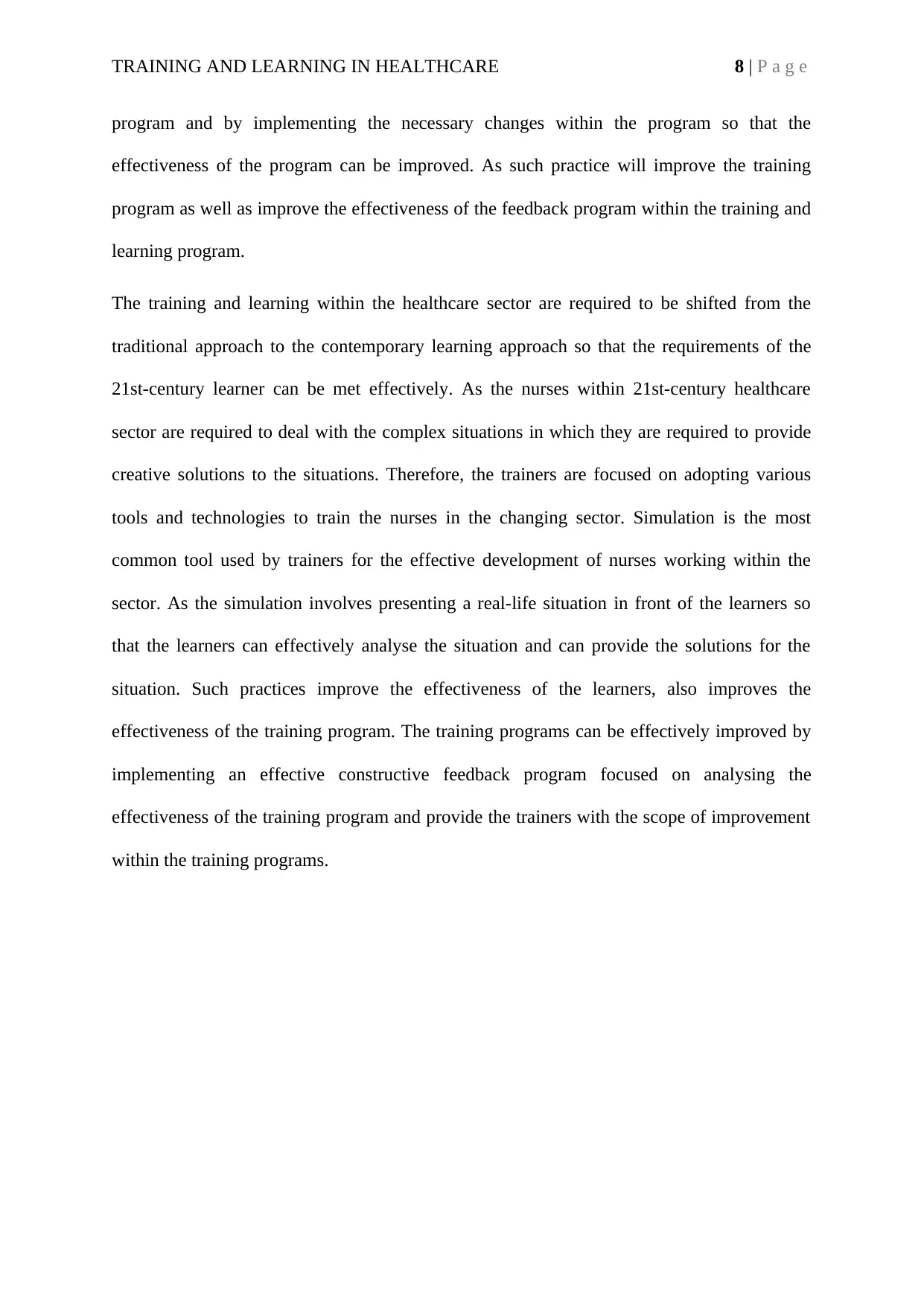
TRAINING AND LEARNING IN HEALTHCARE 8 | P a g e
program and by implementing the necessary changes within the program so that the
effectiveness of the program can be improved. As such practice will improve the training
program as well as improve the effectiveness of the feedback program within the training and
learning program.
The training and learning within the healthcare sector are required to be shifted from the
traditional approach to the contemporary learning approach so that the requirements of the
21st-century learner can be met effectively. As the nurses within 21st-century healthcare
sector are required to deal with the complex situations in which they are required to provide
creative solutions to the situations. Therefore, the trainers are focused on adopting various
tools and technologies to train the nurses in the changing sector. Simulation is the most
common tool used by trainers for the effective development of nurses working within the
sector. As the simulation involves presenting a real-life situation in front of the learners so
that the learners can effectively analyse the situation and can provide the solutions for the
situation. Such practices improve the effectiveness of the learners, also improves the
effectiveness of the training program. The training programs can be effectively improved by
implementing an effective constructive feedback program focused on analysing the
effectiveness of the training program and provide the trainers with the scope of improvement
within the training programs.
program and by implementing the necessary changes within the program so that the
effectiveness of the program can be improved. As such practice will improve the training
program as well as improve the effectiveness of the feedback program within the training and
learning program.
The training and learning within the healthcare sector are required to be shifted from the
traditional approach to the contemporary learning approach so that the requirements of the
21st-century learner can be met effectively. As the nurses within 21st-century healthcare
sector are required to deal with the complex situations in which they are required to provide
creative solutions to the situations. Therefore, the trainers are focused on adopting various
tools and technologies to train the nurses in the changing sector. Simulation is the most
common tool used by trainers for the effective development of nurses working within the
sector. As the simulation involves presenting a real-life situation in front of the learners so
that the learners can effectively analyse the situation and can provide the solutions for the
situation. Such practices improve the effectiveness of the learners, also improves the
effectiveness of the training program. The training programs can be effectively improved by
implementing an effective constructive feedback program focused on analysing the
effectiveness of the training program and provide the trainers with the scope of improvement
within the training programs.
⊘ This is a preview!⊘
Do you want full access?
Subscribe today to unlock all pages.

Trusted by 1+ million students worldwide
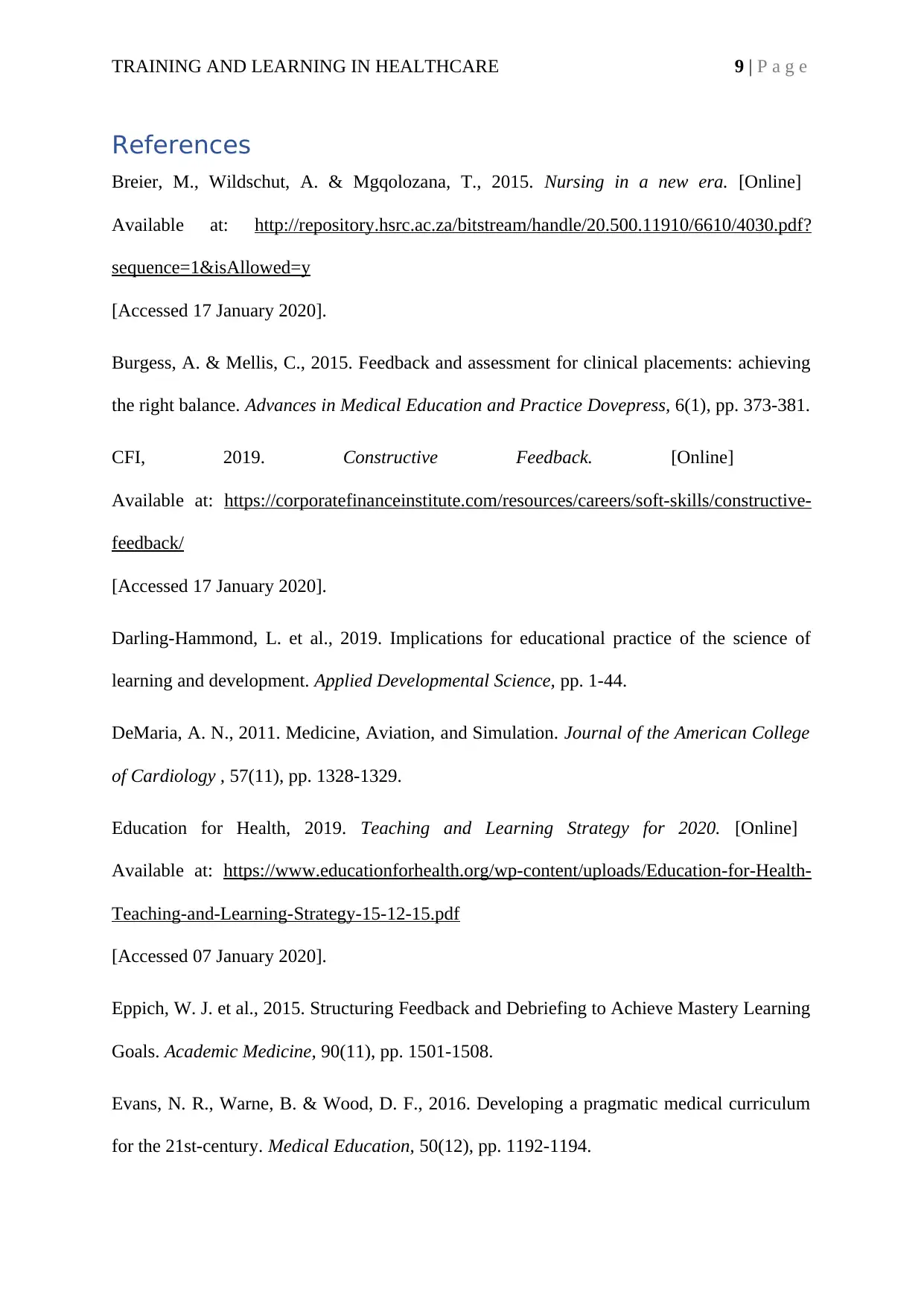
TRAINING AND LEARNING IN HEALTHCARE 9 | P a g e
References
Breier, M., Wildschut, A. & Mgqolozana, T., 2015. Nursing in a new era. [Online]
Available at: http://repository.hsrc.ac.za/bitstream/handle/20.500.11910/6610/4030.pdf?
sequence=1&isAllowed=y
[Accessed 17 January 2020].
Burgess, A. & Mellis, C., 2015. Feedback and assessment for clinical placements: achieving
the right balance. Advances in Medical Education and Practice Dovepress, 6(1), pp. 373-381.
CFI, 2019. Constructive Feedback. [Online]
Available at: https://corporatefinanceinstitute.com/resources/careers/soft-skills/constructive-
feedback/
[Accessed 17 January 2020].
Darling-Hammond, L. et al., 2019. Implications for educational practice of the science of
learning and development. Applied Developmental Science, pp. 1-44.
DeMaria, A. N., 2011. Medicine, Aviation, and Simulation. Journal of the American College
of Cardiology , 57(11), pp. 1328-1329.
Education for Health, 2019. Teaching and Learning Strategy for 2020. [Online]
Available at: https://www.educationforhealth.org/wp-content/uploads/Education-for-Health-
Teaching-and-Learning-Strategy-15-12-15.pdf
[Accessed 07 January 2020].
Eppich, W. J. et al., 2015. Structuring Feedback and Debriefing to Achieve Mastery Learning
Goals. Academic Medicine, 90(11), pp. 1501-1508.
Evans, N. R., Warne, B. & Wood, D. F., 2016. Developing a pragmatic medical curriculum
for the 21st-century. Medical Education, 50(12), pp. 1192-1194.
References
Breier, M., Wildschut, A. & Mgqolozana, T., 2015. Nursing in a new era. [Online]
Available at: http://repository.hsrc.ac.za/bitstream/handle/20.500.11910/6610/4030.pdf?
sequence=1&isAllowed=y
[Accessed 17 January 2020].
Burgess, A. & Mellis, C., 2015. Feedback and assessment for clinical placements: achieving
the right balance. Advances in Medical Education and Practice Dovepress, 6(1), pp. 373-381.
CFI, 2019. Constructive Feedback. [Online]
Available at: https://corporatefinanceinstitute.com/resources/careers/soft-skills/constructive-
feedback/
[Accessed 17 January 2020].
Darling-Hammond, L. et al., 2019. Implications for educational practice of the science of
learning and development. Applied Developmental Science, pp. 1-44.
DeMaria, A. N., 2011. Medicine, Aviation, and Simulation. Journal of the American College
of Cardiology , 57(11), pp. 1328-1329.
Education for Health, 2019. Teaching and Learning Strategy for 2020. [Online]
Available at: https://www.educationforhealth.org/wp-content/uploads/Education-for-Health-
Teaching-and-Learning-Strategy-15-12-15.pdf
[Accessed 07 January 2020].
Eppich, W. J. et al., 2015. Structuring Feedback and Debriefing to Achieve Mastery Learning
Goals. Academic Medicine, 90(11), pp. 1501-1508.
Evans, N. R., Warne, B. & Wood, D. F., 2016. Developing a pragmatic medical curriculum
for the 21st-century. Medical Education, 50(12), pp. 1192-1194.
Paraphrase This Document
Need a fresh take? Get an instant paraphrase of this document with our AI Paraphraser
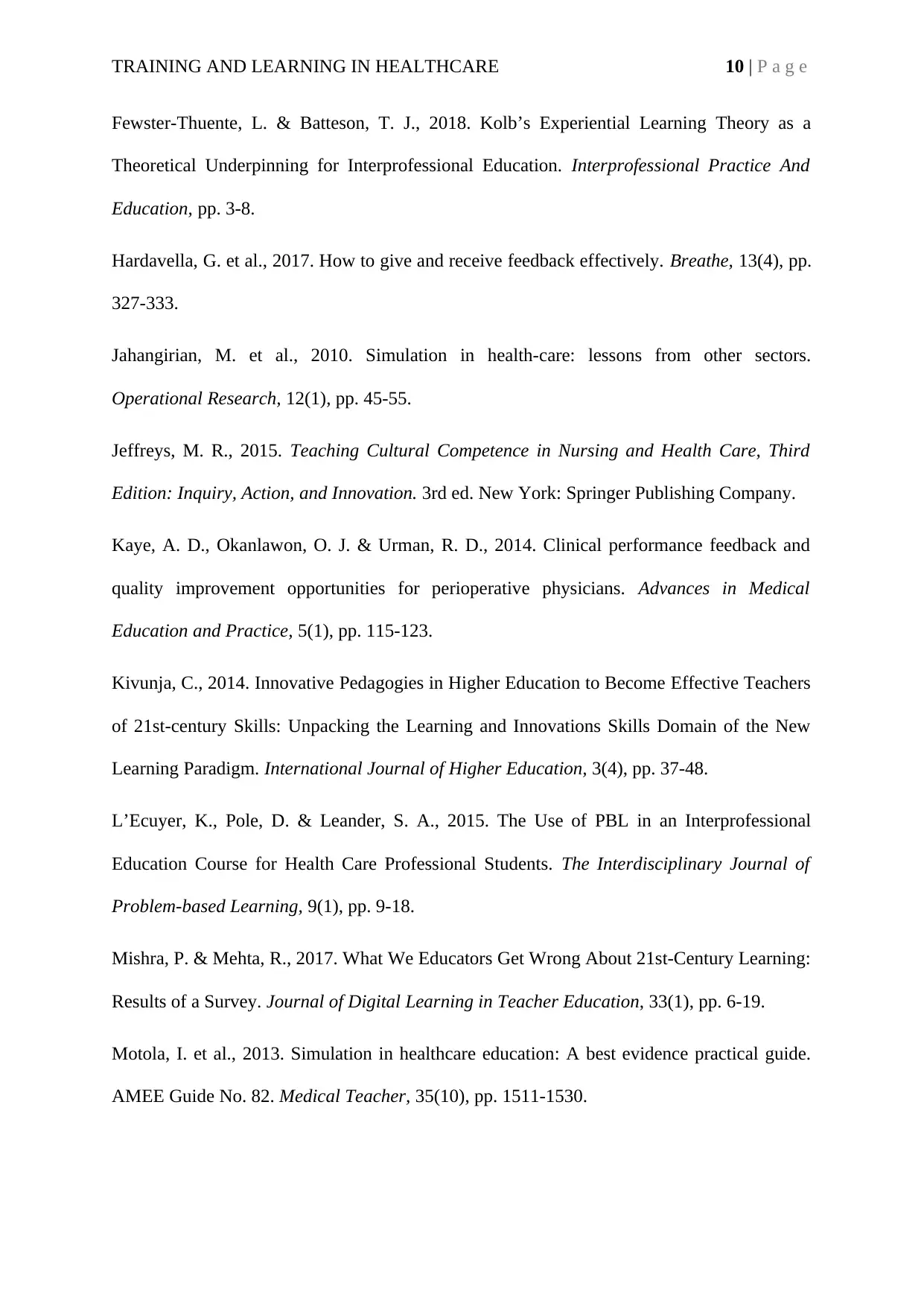
TRAINING AND LEARNING IN HEALTHCARE 10 | P a g e
Fewster-Thuente, L. & Batteson, T. J., 2018. Kolb’s Experiential Learning Theory as a
Theoretical Underpinning for Interprofessional Education. Interprofessional Practice And
Education, pp. 3-8.
Hardavella, G. et al., 2017. How to give and receive feedback effectively. Breathe, 13(4), pp.
327-333.
Jahangirian, M. et al., 2010. Simulation in health-care: lessons from other sectors.
Operational Research, 12(1), pp. 45-55.
Jeffreys, M. R., 2015. Teaching Cultural Competence in Nursing and Health Care, Third
Edition: Inquiry, Action, and Innovation. 3rd ed. New York: Springer Publishing Company.
Kaye, A. D., Okanlawon, O. J. & Urman, R. D., 2014. Clinical performance feedback and
quality improvement opportunities for perioperative physicians. Advances in Medical
Education and Practice, 5(1), pp. 115-123.
Kivunja, C., 2014. Innovative Pedagogies in Higher Education to Become Effective Teachers
of 21st-century Skills: Unpacking the Learning and Innovations Skills Domain of the New
Learning Paradigm. International Journal of Higher Education, 3(4), pp. 37-48.
L’Ecuyer, K., Pole, D. & Leander, S. A., 2015. The Use of PBL in an Interprofessional
Education Course for Health Care Professional Students. The Interdisciplinary Journal of
Problem-based Learning, 9(1), pp. 9-18.
Mishra, P. & Mehta, R., 2017. What We Educators Get Wrong About 21st-Century Learning:
Results of a Survey. Journal of Digital Learning in Teacher Education, 33(1), pp. 6-19.
Motola, I. et al., 2013. Simulation in healthcare education: A best evidence practical guide.
AMEE Guide No. 82. Medical Teacher, 35(10), pp. 1511-1530.
Fewster-Thuente, L. & Batteson, T. J., 2018. Kolb’s Experiential Learning Theory as a
Theoretical Underpinning for Interprofessional Education. Interprofessional Practice And
Education, pp. 3-8.
Hardavella, G. et al., 2017. How to give and receive feedback effectively. Breathe, 13(4), pp.
327-333.
Jahangirian, M. et al., 2010. Simulation in health-care: lessons from other sectors.
Operational Research, 12(1), pp. 45-55.
Jeffreys, M. R., 2015. Teaching Cultural Competence in Nursing and Health Care, Third
Edition: Inquiry, Action, and Innovation. 3rd ed. New York: Springer Publishing Company.
Kaye, A. D., Okanlawon, O. J. & Urman, R. D., 2014. Clinical performance feedback and
quality improvement opportunities for perioperative physicians. Advances in Medical
Education and Practice, 5(1), pp. 115-123.
Kivunja, C., 2014. Innovative Pedagogies in Higher Education to Become Effective Teachers
of 21st-century Skills: Unpacking the Learning and Innovations Skills Domain of the New
Learning Paradigm. International Journal of Higher Education, 3(4), pp. 37-48.
L’Ecuyer, K., Pole, D. & Leander, S. A., 2015. The Use of PBL in an Interprofessional
Education Course for Health Care Professional Students. The Interdisciplinary Journal of
Problem-based Learning, 9(1), pp. 9-18.
Mishra, P. & Mehta, R., 2017. What We Educators Get Wrong About 21st-Century Learning:
Results of a Survey. Journal of Digital Learning in Teacher Education, 33(1), pp. 6-19.
Motola, I. et al., 2013. Simulation in healthcare education: A best evidence practical guide.
AMEE Guide No. 82. Medical Teacher, 35(10), pp. 1511-1530.
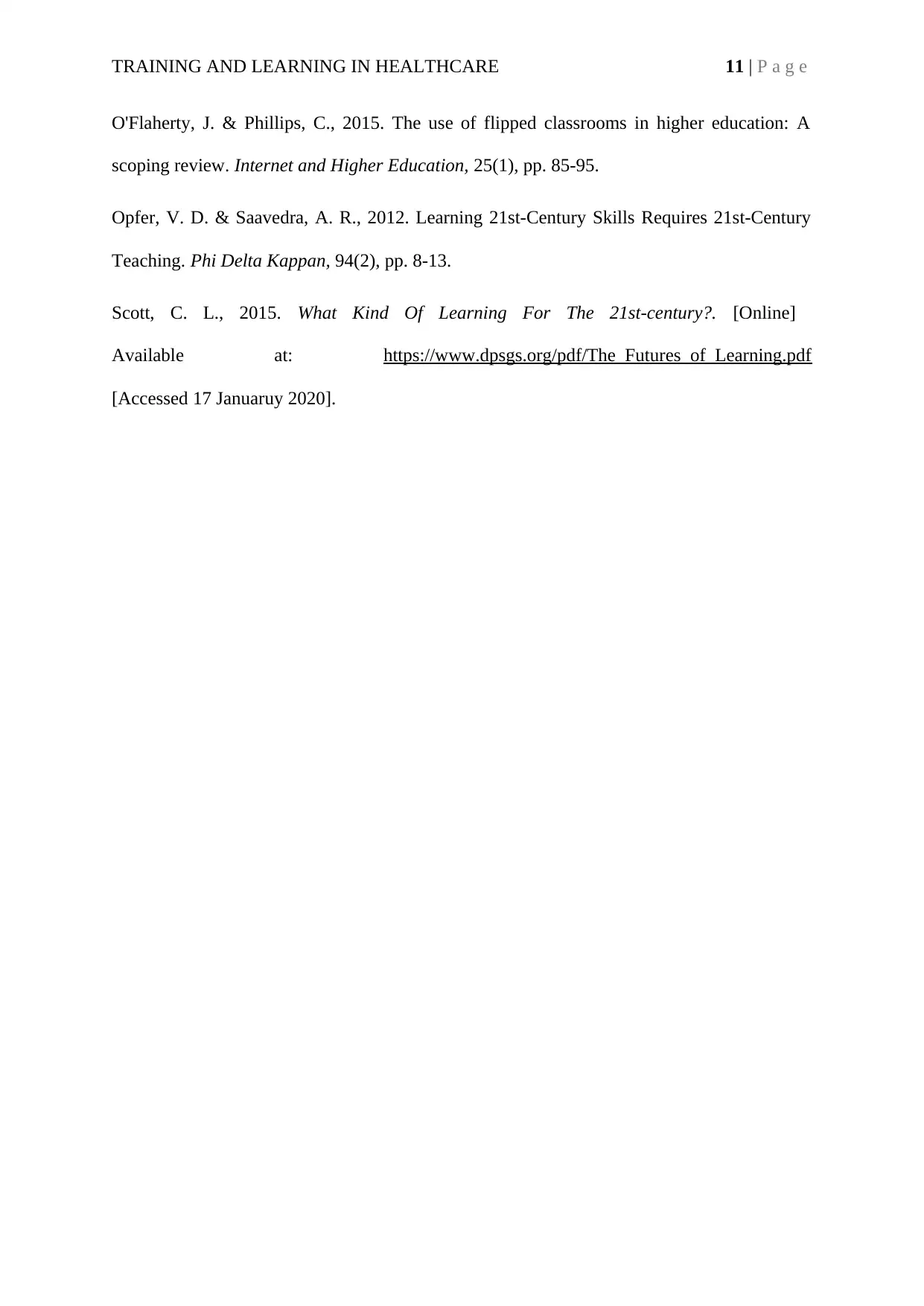
TRAINING AND LEARNING IN HEALTHCARE 11 | P a g e
O'Flaherty, J. & Phillips, C., 2015. The use of flipped classrooms in higher education: A
scoping review. Internet and Higher Education, 25(1), pp. 85-95.
Opfer, V. D. & Saavedra, A. R., 2012. Learning 21st-Century Skills Requires 21st-Century
Teaching. Phi Delta Kappan, 94(2), pp. 8-13.
Scott, C. L., 2015. What Kind Of Learning For The 21st-century?. [Online]
Available at: https://www.dpsgs.org/pdf/The_Futures_of_Learning.pdf
[Accessed 17 Januaruy 2020].
O'Flaherty, J. & Phillips, C., 2015. The use of flipped classrooms in higher education: A
scoping review. Internet and Higher Education, 25(1), pp. 85-95.
Opfer, V. D. & Saavedra, A. R., 2012. Learning 21st-Century Skills Requires 21st-Century
Teaching. Phi Delta Kappan, 94(2), pp. 8-13.
Scott, C. L., 2015. What Kind Of Learning For The 21st-century?. [Online]
Available at: https://www.dpsgs.org/pdf/The_Futures_of_Learning.pdf
[Accessed 17 Januaruy 2020].
⊘ This is a preview!⊘
Do you want full access?
Subscribe today to unlock all pages.

Trusted by 1+ million students worldwide
1 out of 12
Related Documents
Your All-in-One AI-Powered Toolkit for Academic Success.
+13062052269
info@desklib.com
Available 24*7 on WhatsApp / Email
![[object Object]](/_next/static/media/star-bottom.7253800d.svg)
Unlock your academic potential
Copyright © 2020–2025 A2Z Services. All Rights Reserved. Developed and managed by ZUCOL.





